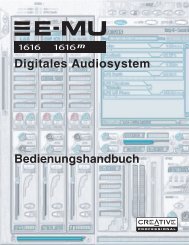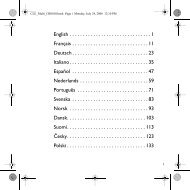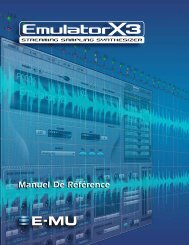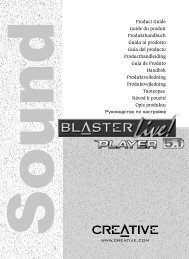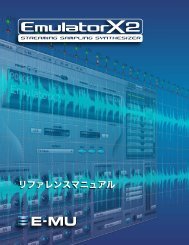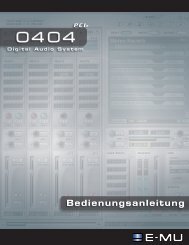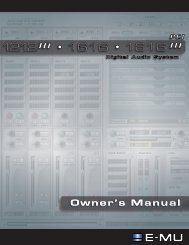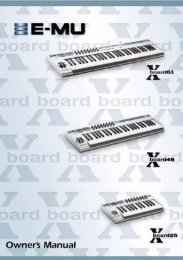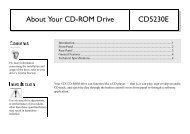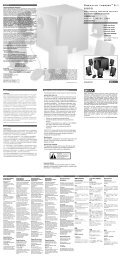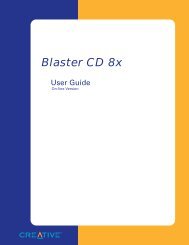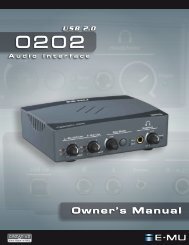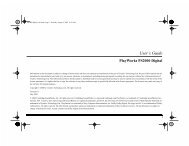Create successful ePaper yourself
Turn your PDF publications into a flip-book with our unique Google optimized e-Paper software.
3 - PCI Card & Interfaces<br />
The Sync Daughter Card Option<br />
The Sync Daughter Card Option<br />
The Sync Daughter card option adds word clock in and out, SMPTE (LTC) in and out<br />
and an additional MIDI output for transmitting MIDI Time Code (MTC). MIDI Time<br />
Code is a special rendering of SMPTE that can be transmitted over MIDI cables. For<br />
additional information about SMPTE, please refer to SMPTE Background.<br />
Synchronization is a basic technique needed for connecting multiple pieces of<br />
equipment. Word Clock, S/PDIF or S/PDIF optical are all industry standard methods of<br />
synchronizing digital equipment together at the system sample rate (44.1kHz, 48kHz,<br />
or 96kHz). The master clock source is set in the Mixer Session Settings menu. See<br />
System Settings for more information.<br />
Recording equipment can also be synchronized so that two audio recorders or an audio<br />
and video recorder can lock together as a single machine. SMPTE and MTC sync are used<br />
because they convey absolute time information. Word clock, or S/PDIF sync only<br />
synchronize the sample rate and unlike SMPTE and MTC, do not convey song position<br />
information. In a synchronized system, there is usually one MASTER machine, and one<br />
or more SLAVES. When the master starts, the others will follow (chase).<br />
The Sync Daughter card is also a format converter. It converts incoming SMPTE time<br />
code to MIDI Time Code (MTC) and passes this information to the host computer to be<br />
used by a sequencer or audio recorder application. When your computer application is<br />
the “Master”, the Sync Daughter card converts MTC into SMPTE and sends it out to<br />
another SMPTE device.<br />
Word Clock<br />
SMPTE<br />
MTC Out<br />
In<br />
Out<br />
In<br />
Out<br />
Connecting Cables to the Sync<br />
Daughter Card<br />
The Sync Daughter Card contains Word Clock<br />
inputs and outputs for clock signals used in a<br />
studio where a common sample rate reference is<br />
required to keep multiple pieces of digital<br />
equipment running together. This is referred to<br />
as “house clock” or “house sync,” and is set to<br />
the actual sample rate of the system. Use a cable<br />
with BNC connectors to connect incoming clock<br />
signals to the Word Clock In jack on the Sync<br />
Daughter card. Connect the Word Clock Out to<br />
your other digital equipment to use the Sync<br />
Daughter Card as the Master Word Clock source.<br />
See Word Clock In/Out.<br />
The Sync Daughter Card provides SMPTE (LTC)<br />
sync in and out on two 1/4” phone jacks. LTC<br />
can be recorded onto an unused audio track on<br />
an analog or digital recorder and then fed back<br />
into the SMPTE input to synchronize your<br />
computer sequencer/recorder. See SMPTE<br />
Background for more information.<br />
MIDI Time Code is also output whenever MTC<br />
is being generated by the host application<br />
(sequencer or audio recorder). A special cable<br />
converts the mini DIN to a standard MIDI jack.<br />
See the Sync Daughter Card Supplement for more information about using the Sync<br />
Daughter Card.<br />
8 <strong>Creative</strong> Professional



